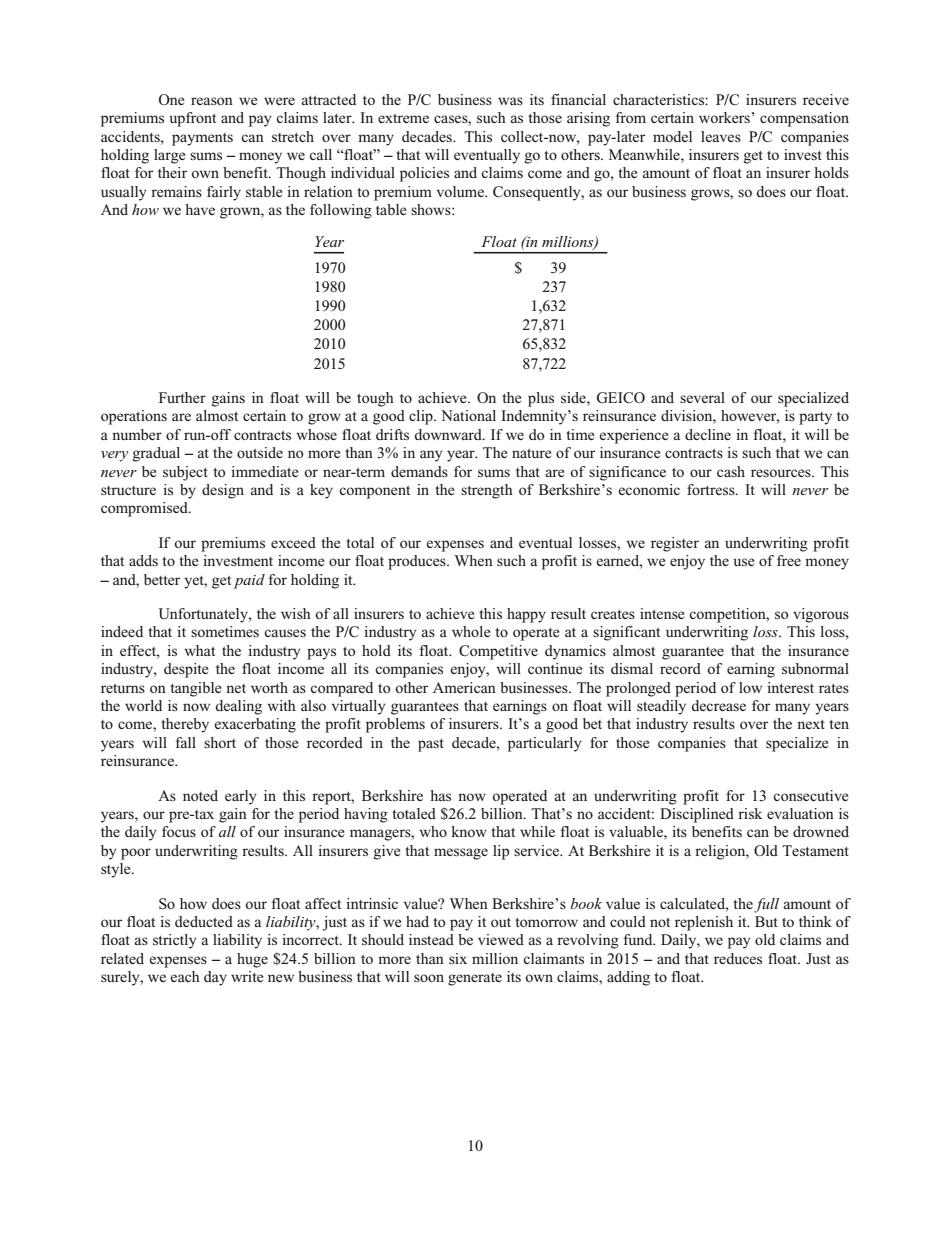正在加载图片...

characteristics:P/C insurers receive 网ehog可杰is clle y we call "float that will eventually go to othe Though individual policies and come al daheanmeontofaoatninsurerhol sequently,as our And how we have grown.as the following table shows: ess grows,so Year Float (in millions) 1000 163 2000 27.871 2010 65,83 2015 87,722 Further gains in float will be tough to achieve.On the plus side,GEICO and several of our specialized operations re alm st certain to grow at a goo lip.Natic Inde nity s reinsurance divi on,hov dforholdingL in effect,is what the industry pays to hold its float.Competitive dynamics almost guarantee that the insuranc industry,despite the float income all its comp anies enjoy,will continue its dismal record of aming subnorma 00 er Am or erest rate that to come,ther by exacerbating the profit problems of insurers.It'sa good bet that industry results over the next ten wall short of those recorded in the past decade,particularly for those companies that specialize in As noted e early in on that whil n he deriting reuAll insrergive that message lip serviceAt Berkshire t is religion,Testa So how does our float affect intrinsic value?When Berkshire's book value is calculated,the fill amount of 0rtnoatisdkduct d as a fiability,Just as a lia a revol float.One reason we were attracted to the P/C business was its financial characteristics: P/C insurers receive premiums upfront and pay claims later. In extreme cases, such as those arising from certain workers’ compensation accidents, payments can stretch over many decades. This collect-now, pay-later model leaves P/C companies holding large sums – money we call “float” – that will eventually go to others. Meanwhile, insurers get to invest this float for their own benefit. Though individual policies and claims come and go, the amount of float an insurer holds usually remains fairly stable in relation to premium volume. Consequently, as our business grows, so does our float. And how we have grown, as the following table shows: Year Float (in millions) 1970 $ 39 1980 237 1990 1,632 2000 27,871 2010 65,832 2015 87,722 Further gains in float will be tough to achieve. On the plus side, GEICO and several of our specialized operations are almost certain to grow at a good clip. National Indemnity’s reinsurance division, however, is party to a number of run-off contracts whose float drifts downward. If we do in time experience a decline in float, it will be very gradual – at the outside no more than 3% in any year. The nature of our insurance contracts is such that we can never be subject to immediate or near-term demands for sums that are of significance to our cash resources. This structure is by design and is a key component in the strength of Berkshire’s economic fortress. It will never be compromised. If our premiums exceed the total of our expenses and eventual losses, we register an underwriting profit that adds to the investment income our float produces. When such a profit is earned, we enjoy the use of free money – and, better yet, get paid for holding it. Unfortunately, the wish of all insurers to achieve this happy result creates intense competition, so vigorous indeed that it sometimes causes the P/C industry as a whole to operate at a significant underwriting loss. This loss, in effect, is what the industry pays to hold its float. Competitive dynamics almost guarantee that the insurance industry, despite the float income all its companies enjoy, will continue its dismal record of earning subnormal returns on tangible net worth as compared to other American businesses. The prolonged period of low interest rates the world is now dealing with also virtually guarantees that earnings on float will steadily decrease for many years to come, thereby exacerbating the profit problems of insurers. It’s a good bet that industry results over the next ten years will fall short of those recorded in the past decade, particularly for those companies that specialize in reinsurance. As noted early in this report, Berkshire has now operated at an underwriting profit for 13 consecutive years, our pre-tax gain for the period having totaled $26.2 billion. That’s no accident: Disciplined risk evaluation is the daily focus of all of our insurance managers, who know that while float is valuable, its benefits can be drowned by poor underwriting results. All insurers give that message lip service. At Berkshire it is a religion, Old Testament style. So how does our float affect intrinsic value? When Berkshire’s book value is calculated, the full amount of our float is deducted as a liability, just as if we had to pay it out tomorrow and could not replenish it. But to think of float as strictly a liability is incorrect. It should instead be viewed as a revolving fund. Daily, we pay old claims and related expenses – a huge $24.5 billion to more than six million claimants in 2015 – and that reduces float. Just as surely, we each day write new business that will soon generate its own claims, adding to float. 10